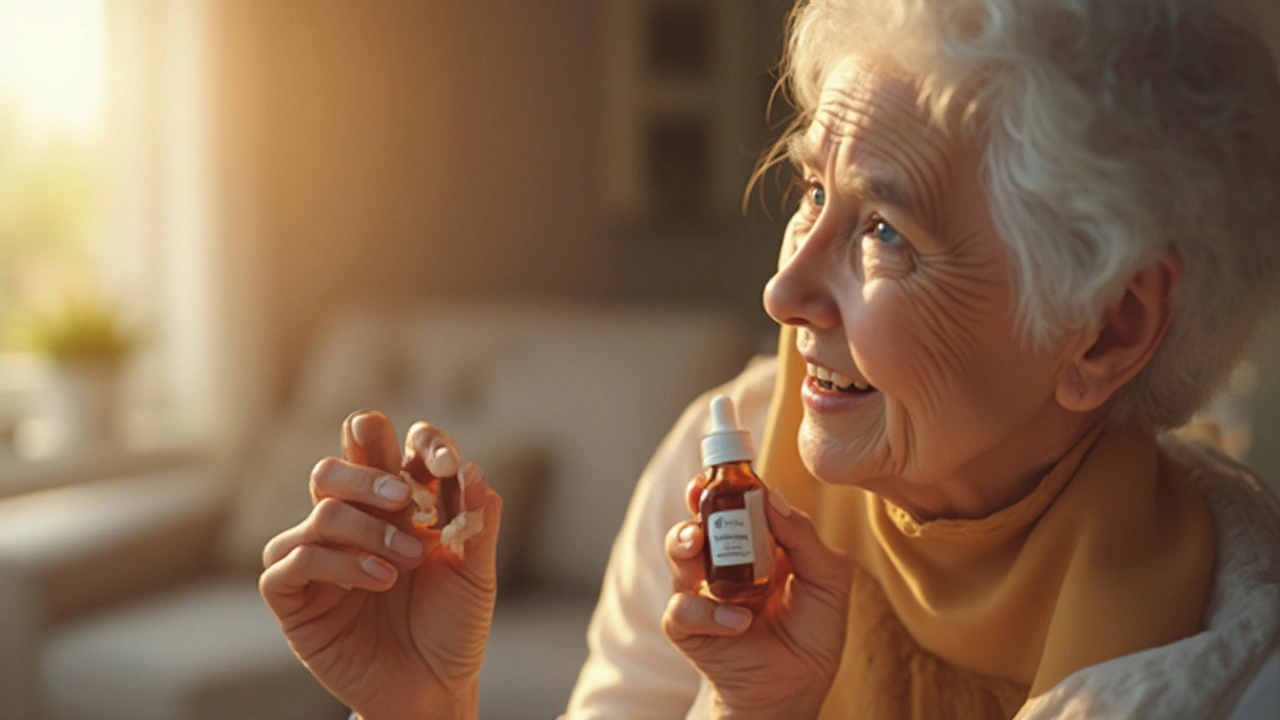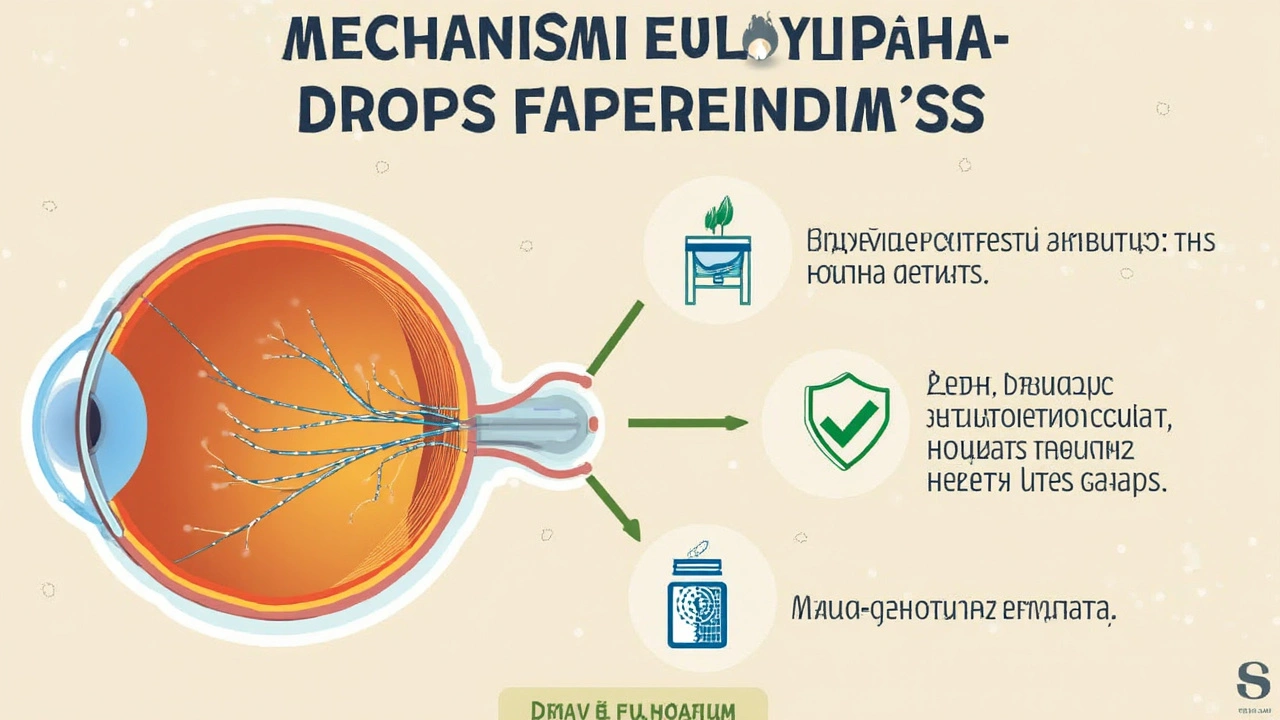Alphagan Eye Drops: Uses, Benefits, Side Effects, and User Guide
 Jun, 20 2025
Jun, 20 2025
Grab any bottle of eye drops off a pharmacy shelf and it’s pretty basic: relieve redness, moisten dry eyes, or maybe clear up itchiness. But Alphagan belongs to a whole different league. It’s not just another squirt to soothe irritation—it’s a powerful prescription eye drop that’s saved the sight of millions dealing with high eye pressure and glaucoma. Imagine the world slowly fading at the edges, colors dulling, and details slipping away. That’s what untreated glaucoma can do, quietly and sneakily. So, understanding what Alphagan brings to the table matters big time for anyone trying to protect their vision.
What is Alphagan and How Does It Work?
Alphagan, also known as brimonidine tartrate, is a prescription eye drop mainly used to lower raised pressure in the eyeball. When eye pressure climbs, it squeezes the optic nerve, which is the main messenger to your brain for getting visual information. This constant pressure isn’t just uncomfortable—it can slowly damage nerve fibers, especially in people with open-angle glaucoma or ocular hypertension. Here’s where Alphagan steps in. It works by targeting alpha-2 adrenergic receptors in the eye. When these receptors are activated, the eye produces less fluid inside, called aqueous humor, and at the same time helps more fluid drain out through natural channels. The magic is in this two-way approach: less buildup, more outflow.
Brimonidine is not the oldest player in the field—beta blockers and prostaglandin analogs also get used for the same job—but it’s known for being gentle enough that some people who can’t tolerate other medications can use it symptom-free. Alphagan got its first FDA approval in 1996, and the improved "Alphagan P" version, which cuts down on preservatives that can irritate the eye, came later. Research from the Journal of Glaucoma in 2023 showed that brimonidine can cut intraocular pressure by around 20–24% when used as directed. That percentage makes a huge difference over time.
What’s unique is that Alphagan is also sometimes prescribed off-label for people who get dry eyes or redness from long-term glaucoma therapy, since it doesn’t cause as much stinging or allergic reaction as some other drops. That’s especially helpful for corneas that are already sensitive.
When is Alphagan Used—And Who Should Consider It?
Most people meet Alphagan in their ophthalmologist’s office, often after a routine eye pressure check—or maybe after a brush with blurry vision or halos around lights. The classic cases are open-angle glaucoma and ocular hypertension, where pressure in the eye gets higher than it should be, putting the optic nerve at risk. Globally, glaucoma affects more than 76 million people, according to a World Health Organization estimate from 2024, and it’s still the leading cause of irreversible blindness. It sneaks up—half of those with it don’t even know they have it until they’ve lost a lot of sight.
Some folks get prescribed Alphagan as a first-line treatment, but it’s more common for doctors to try a prostaglandin analog (like latanoprost) first, or a beta blocker (like timolol). If those cause side effects—maybe heart rate drops, asthma flares, red eyes that won’t quit—that’s when Alphagan steps up. It’s also a player in combination therapy, when one drop alone can’t get pressure low enough. You might use Alphagan alongside other drops, sometimes with as many as three medications mixed and matched for best results.
Kids and teens aren’t typical users (the FDA doesn’t recommend Alphagan for children under two, and even older kids should be closely watched). Pregnant people only use it if it’s absolutely needed. Those with severe heart disease or a history of depression or low blood pressure need to chat with their doctor about risks. And—the kicker—contact lens wearers need a heads up too, because preservatives in the drop can soak into soft lenses and cause irritation. The preservative-free formulas help here, but you should always remove your lenses before dosing.
For people with a family history of blindness or those diagnosed with increased intraocular pressure in their 40s or 50s, being proactive with medication like Alphagan can mean the difference between keeping and losing vision. Spotted early, treated properly, and monitored regularly, most people hold onto their eyesight for life.

How to Use Alphagan Correctly—And Avoid Common Slip-Ups
Every medication works better when it’s taken right, and eye drops are no exception. With Alphagan, doctors usually recommend a dose of one drop in each affected eye, two or three times daily, spaced about eight hours apart. The timing is pretty crucial; don’t double up if you forget a dose, just get back on schedule next time. Here’s how to nail the routine and sidestep the classic mistakes:
- Wash your hands before opening the bottle. Dirty fingers breed infection.
- Don’t let the tip of the bottle touch your eye, lashes, or skin—again, germs are everywhere.
- After putting in a drop, close your eye, then gently press your finger to the inner corner of your eyelid (near your nose) for about a minute. That holds the medication in place and keeps it from draining down your throat (which can cause side effects).
- If you use other drops, wait at least 5–10 minutes between them so each medicine soaks in properly.
- Keep the bottle tightly capped and store at room temperature, away from sunlight and moisture.
Some people worry because the first time they use Alphagan, it can cause mild stinging, blurred vision, or redness. These usually pass in a few minutes. If burning, allergic swelling, or a rash hits and doesn’t fade, that’s a sign to call the doctor—even rare side effects are worth mentioning. For people who wear contacts, it’s best to wait at least 15 minutes before popping lenses back in after using the drop.
Those who travel or spend a lot of time in dry or windy places might want to keep preservative-free vials on hand, just to sidestep irritation. And—surprisingly—using artificial tears or lubricating drops 10–15 minutes apart from Alphagan can also take the edge off dryness that comes with long-term use. Forgetting doses or quitting when things "feel better" spells trouble—glaucoma rarely causes pain or obvious symptoms early on, so keeping to the drop schedule matters even if your vision seems fine.
A Closer Look at Side Effects and Safety
Every medication has a double edge, and Alphagan is no exception. Most people get through their course with just a little eye redness or mild irritation, usually within the first hour after application. About 10–15% might notice dry mouth, slight drowsiness, or headaches—this happens if a trace amount of the drop slips into the bloodstream. That’s why pinching the nose after application is such a game changer. Here’s a breakdown of the numbers from a multicenter clinical trial in 2023 that tracked typical side effects after six months of use:
| Side Effect | Frequency (out of 100 users) |
|---|---|
| Eye redness | 23 |
| Dry mouth | 12 |
| Fatigue/drowsiness | 9 |
| Allergic reaction (itchy, swollen eyes) | 7 |
| Blurred vision (short-term) | 6 |
Rarely, people—especially those who use the drop several times a day for months—might develop follicular conjunctivitis, which means small bumps on the inside of the eyelid. If your eyes swell, itch, or water more with every dose, or if your eyelids start to droop, call your doctor.
Alphagan can drop your blood pressure or slow your heart rate, but this usually only happens in those with pre-existing cardiac problems, or if the medication makes its way into the bloodstream. For children under five, the risk of drowsiness or slowed breathing is higher, so most guidelines steer clear of prescribing it in young kids.
If you take other medications (especially antidepressants, blood pressure drugs, or sleeping pills), make sure your doctor knows. Brimonidine can interact with certain meds, amping up drowsiness or lowering blood pressure unexpectedly.
A little-known twist: some folks notice pale skin, fatigue, or fever with long-term brimonidine. Although that’s rare, those are good reasons to check in with your doctor for lab work if you feel off while using the drops. And one simple trick to minimize side effects: always use the minimal effective dose—and stick with the preservative-free formula if irritation pops up.

Tips, Alternatives, and Daily Life with Alphagan
Living with a twice or thrice daily eye drop might sound like a hassle, but the routine quickly becomes second nature for most. Here are some easy tips that make it feel less daunting:
- Set phone reminders for every dose when starting out—consistency beats accidental forgetfulness.
- Keep a drop bottle in your work bag or car for daytime doses, especially if your schedule is unpredictable.
- If you struggle with shaky hands or coordination, ask your pharmacy about eye drop aids—small plastic tools that help steady the bottle and aim it right.
- Track changes in vision with a simple notebook. Jot down any blurriness, halos, or new symptoms, because trends can help your doctor tweak your meds.
- If costs are an issue, ask about generic brimonidine tartrate—it’s as effective as brand-name Alphagan and usually much cheaper.
Sometimes, people worry that using drops "for life" is a negative. But the reality: the risk of losing sight without treatment is much higher. If you’re having trouble keeping to a schedule, combo drops (which blend medications like brimonidine and timolol together) often cut down on bottles and simplify things. Laser procedures or surgical options exist for people whose pressure won’t budge—though for many, medication stays the first choice for years.
Don’t skip your usual eye exams, by the way. Even if every drop goes in perfectly, new changes can pop up unnoticed. Routine scans and check-ups help spot small changes in eye pressure or nerve health before they turn serious.
Finally, for anyone with a new diagnosis—or trying to help a parent or older relative deal with vision changes—finding community groups or online forums can offer support, tips, and reassurance. A surprising number of people, from athletes to teachers, rely on Alphagan to keep their peripheral vision clear so they can keep driving, reading, and enjoying life without fear. Alphagan isn’t a miracle, but for millions, it’s made holding on to vision possible—one drop at a time.

Breanna Mitchell
July 18, 2025 AT 17:02This guide on Alphagan eye drops really cleared up a lot for me! Glaucoma is such a scary diagnosis, but knowing how these drops help reduce intraocular pressure brings some relief.
What I especially liked is the practical advice on usage. Sometimes we rush through instructions and end up using meds incorrectly. The tip about applying gentle pressure to the tear duct after using the drops is a game-changer!
Also, understanding side effects beforehand helps me feel more confident and prepared. Has anyone experienced dryness or mild stinging with Alphagan? How long did it last for you?
Overall, I appreciate the clear benefits highlighted. It’s encouraging to see that this can slow vision loss if used consistently.
Alice Witland
July 21, 2025 AT 03:38Ah, another “miracle” drop to the rescue? Seems like every month there’s a new wonder drug for glaucoma, and here we are still squinting through the haze.
Jokes aside, I find the dry, clinical tone in these guides rather amusing — I'll take the guide with a pinch of salt and a load of skepticism until I see real-world success from patients.
Still, to give credit where it's due, the safety advice is a nice touch. Hopefully, the benefits outweigh the supposedly mild side effects. Has anyone seen any scientific studies backing these claims up properly? I’m a bit tired of promises without hard evidence.
Chris Wiseman
July 23, 2025 AT 14:15Oh, the perennial pharmaceutic salvation saga, wrapped neatly in a tiny bottle no less—the Alphagan eyedrops, a modern-day panacea for glaucomatous woes—or perhaps just another cog in the ever-turning machine of medical capitalism.
But let's not dwell purely in cynicism. This guide, while comprehensive, barely scratches the surface of what truly occurs at a cellular level when one applies such a potent agent to the delicate ocular tissues. How do we reconcile the supposed benefits with the inevitable biochemical disruptions?
Furthermore, the philosophical question lingers: do we treat the symptom, or the essence of the disease? An existential pondering for those captivated by the complex interplay between medicine and identity.
Michelle Wigdorovitz
July 25, 2025 AT 22:05I've been using Alphagan for a few months now, and while the guide was super helpful, I want to add some personal experience. Initially, my eyes were quite irritated, though it settled down within a week.
One thing I wasn’t expecting was the occasional feeling of dry mouth — a weird side effect that wasn’t highlighted as much. Has anyone else experienced this?
Also, I find that setting daily alarms helped me keep the schedule tight since consistency really matters here. Little hacks like that definitely contribute to better outcomes.
Would love to hear from others about managing side effects practically!
Arianne Gatchalian
July 28, 2025 AT 05:55This post is a wonderful resource! As someone who works in the healthcare field, I often see patients confused about their eye drop treatments. The detailed benefits and side effect section is especially helpful to set correct expectations.
One tip I'd add is to educate patients about the importance of hygiene before administering the drops, which helps minimize the risk of infections.
Also, it's crucial they understand that compliance hugely affects treatment efficacy — skipping doses can be detrimental.
Great job outlining these key points clearly.
Aly Neumeister
July 30, 2025 AT 13:45Can anyone explain why sometimes the drops feel warm and other times just cold? I swear there’s no consistency between batches.
Is it just me or do the side effects like mild redness sometimes appear after not using them for a day or two?
Also, how much do you guys trust these guides compared to what your doctors tell you? I feel like docs are sometimes just winging it with this stuff.
A bit paranoid maybe, but I want to hear thoughts from those who've been walking this road longer.
Martin Gilmore
August 1, 2025 AT 21:35Does anyone else get annoyed by how many times the instructions remind you not to blink or rub your eyes after applying these drops? I mean seriously, isn’t that common sense?
Also, the emphasis on storing the bottle properly — I swear people treat it like a holy relic.
But in all honesty, I’ve noticed that precision matters with these medications more than with any other. One drop too many and your vision feels like a kaleidoscope.
Anyone else experienced some pretty bizarre visual disturbances shortly after using Alphagan?
Quinn S.
August 4, 2025 AT 05:25To clarify, the pharmacodynamics of Alphagan (brimonidine) involve selective alpha-2 adrenergic agonism, which reduces aqueous humor production and increases uveoscleral outflow. Proper administration technique is paramount to maximize absorption and minimize systemic side effects.
Moreover, the potential side effects, including drowsiness and dry mouth, should not be overlooked, particularly in patients with cardiovascular or respiratory conditions.
Strict adherence to recommended dosages, as well as monitoring for adverse reactions, is non-negotiable for optimal therapeutic outcomes.
Dilip Parmanand
August 6, 2025 AT 13:15Quick question for the community: Is there a recommended time of day that's best for Alphagan drop application? I’m assuming consistency is key but does morning versus night impact effectiveness or side effects?
Also curious if anyone has combined these with other glaucoma meds and how that experience was.
Sarah Seddon
August 8, 2025 AT 21:05Such an informative post! I just want to encourage everyone using Alphagan to stay positive — managing glaucoma can feel overwhelming but these drops do a lot of good if you stay consistent and follow safety tips.
Don’t hesitate to reach out to your eye doctor if you feel something is off or side effects are intense!
Remember, eye health is vital for quality of life, and you’re not alone on this journey.
Ari Kusumo Wibowo
August 11, 2025 AT 04:55I’ve been on Alphagan for a couple of years, and honestly, it made a huge difference in controlling the pressure without making me feel groggy like some other meds did.
However, it’s important everyone knows it’s not a cure but a management tool. Regular checkups remain essential.
Also, combining it with prescribed lifestyle changes seems to improve outcomes. Anyone else here finding success with that combo?